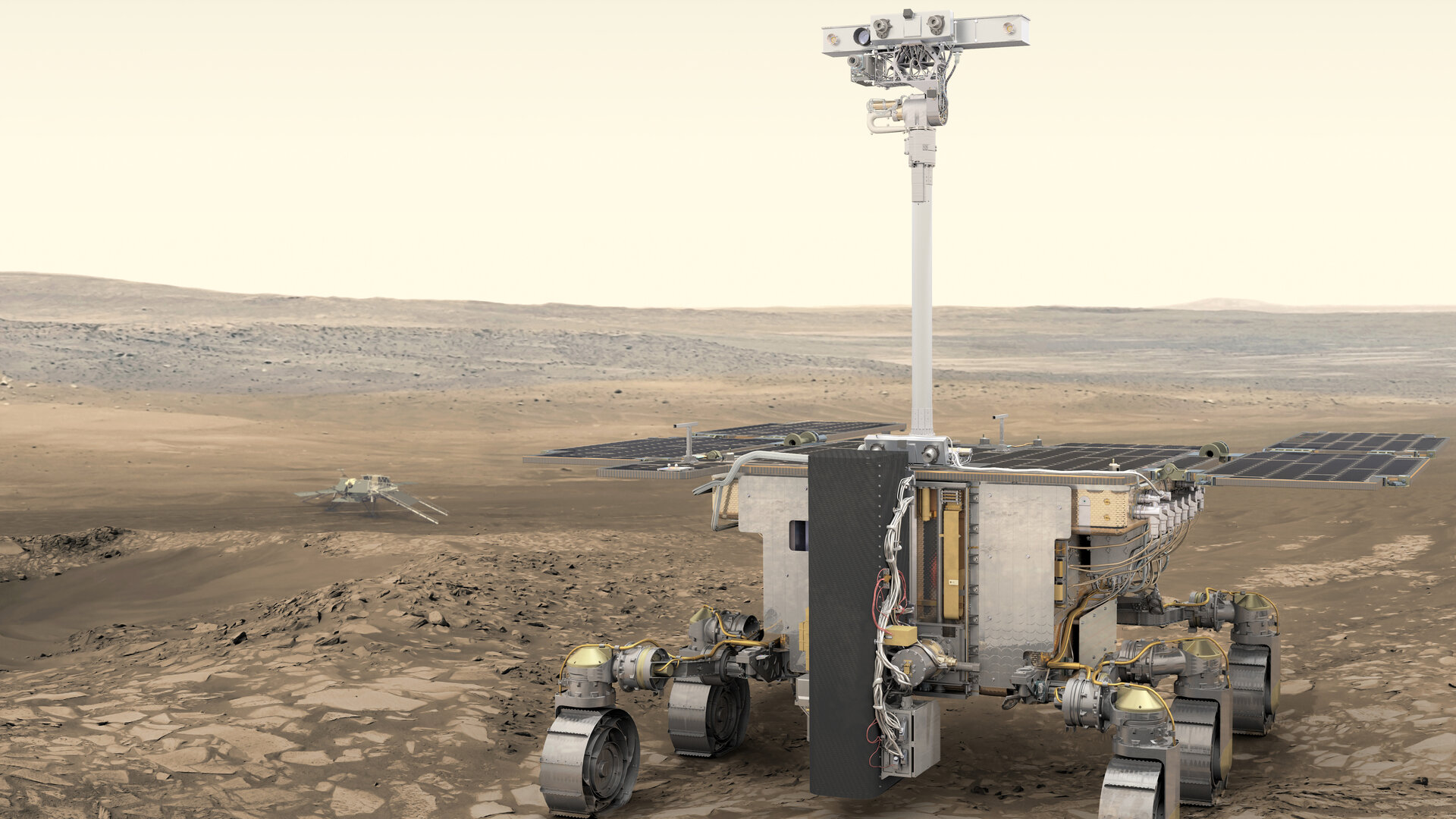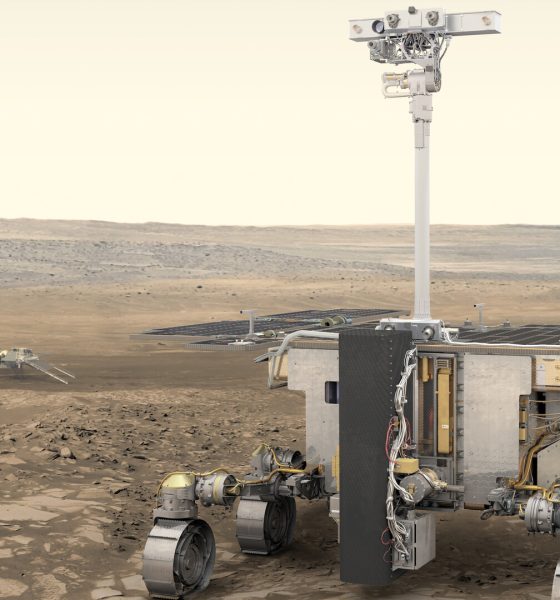

Space
Mars exploration in focus as Europe prepares ExoMars Rover for search of life
2020 may be the year humanity takes its biggest step toward finding evidence of life beyond Earth. NASA and the European Space Agency (ESA) are each working on its own rover that will roam Mars’s surface in search of life.
The ExoMars mission is Europe’s first Mars rover. Named after British DNA pioneer Rosalind Franklin, the golf cart-sized robot is approximately one-third the size of NASA’s planned Mars 2020 rover and will look for signs that life might have existed on Mars.
Both rovers will act as remote scientists, beaming back a wealth of data and images to Earth.
Mars 2020 will collect Martian samples for eventual return to Earth sometime in the future, while ExoMars will use its unique drill to burrow below the surface. Here, the rover will find pristine samples that were shielded from the harsh radiation bombarding Mars’s surface. Scientists are hopeful that below the surface is where we could find our first evidence of life.
A Rover’s Purpose
Mars is a hostile place. Because its atmosphere is much thinner than Earth’s, life as we know it would have a difficult time surviving on the surface.
Billions of years ago, the surface of Mars was probably quite similar to that of Earth. However, that changed when Mars lost its magnetic field, which stripped its atmosphere, and exposed its surface to intense radiation. All of which made survival above ground incredibly challenging.
Historically, Mars missions have searched for signs of life on the planet’s surface, usually at places where there are signs of ancient water. That’s because this is typically where we find life on Earth.
But since we haven’t found life on the planet’s surface yet, mission scientists propose we need to dig deeper. There may be some microbial Martians underground.
The ExoMars rover (and accompanying lander) are a follow-on to ESA’s ExoMars Orbiter mission which reached Mars in 2016. That initial mission consisted of two parts: the Trace Gas Orbiter (TGO) and the Schiaparelli landing demonstrator.
Landing on Mars
TGO made it to Mars and is doing great, however, Schiaparelli didn’t fare so well — the lander crashed during its descent to the Martian surface.
Landing a probe on Mars is not easy. To safely navigate the tenuous Martian atmosphere requires a combination of sophisticated landing gear, including heat shields, retrorockets, and even giant, inflatable airbags.
Despite the crash landing, Schiaparelli achieved its goal as a technology demonstrator. It also showed that the team needed to revamp the landing system before the rover launches. But, with less than a year till liftoff, the rover team is struggling with an established piece of landing architecture: parachutes.
In order to slow the rover down, the mission requires multiple parachutes — one 15 meters (49 feet) in diameter and one 35 meters (115 feet).
As the rover begins its descent, atmospheric drag will slow the craft from around 21 000 km/h (13,048 mph) to 1700 km/h (1,056 mph). That’s when the first parachute will deploy. About 20 seconds later, at about 400 km/h (248 mph), the second chute will deploy. Lastly, the braking engines will kick in about 1 km (or half a mile) above the ground, enabling the rover land safely on the Martian surface.
The entire sequence takes just six minutes.
Parachute Troubles
During high-altitude testing conducted earlier this year, the craft’s parachutes ripped as soon as they deployed. ESA engineers made several adjustments, including reinforcing both the parachutes and their storage bags with Teflon to make them deploy easier. The chutes are still tearing.
Now the agency is turning to NASA for help. ESA engineers are teaming up with the folks at the Jet Propulsion Laboratory, to put the enhanced parachutes through months of rigorous testing.
In the meantime, the rover team is putting its hardware through a round of thermal testing. For 18 days it will be subjected to the same harsh temperature conditions experienced on Mars.
The parachutes are expected to finish testing sometime in April 2020; they will then be integrated with the rover and shipped to the launch site in Kazakhstan. However, if any part of the mission misses its deadline, the entire project could be sidelined until the next favorable Mars launch window — in 2022.
Check out Teslarati’s Marketplace! We offer Tesla accessories, including for the Tesla Cybertruck and Tesla Model 3.

News
SpaceX shades airline for seeking contract with Amazon’s Starlink rival

SpaceX employees, including its CEO Elon Musk, shaded American Airlines on social media this past weekend due to the company’s reported talks with Amazon’s Starlink rival, Leo.
Starlink has been adopted by several airlines, including United Airlines, Qatar Airways, Hawaiian Airlines, WestJet, Air France, airBaltic, and others. It has gained notoriety as an extremely solid, dependable, and reliable option for airline travel, as traditional options frequently cause users to lose connection to the internet.
Many airlines have made the switch, while others continue to mull the options available to them. American Airlines is one of them.
A report from Bloomberg indicates the airline is thinking of going with a Starlink rival owned by Amazon, called Leo. It was previously referred to as Project Kuiper.
American CEO Robert Isom said (via Bloomberg):
“While there’s Starlink, there are other low-Earth-orbit satellite opportunities that we can look at. We’re making sure that American is going to have what our customers need.”
Isom also said American has been in touch with Amazon about installing Leo on its aircraft, but he would not reveal the status of any discussions with the company.
The report caught the attention of Michael Nicolls, the Vice President of Starlink Engineering at SpaceX, who said:
“Only fly on airlines with good connectivity… and only one source of good connectivity at the moment…”
CEO Elon Musk replied to Nicolls by stating that American Airlines risks losing “a lot of customers if their connectivity solution fails.”
American Airlines will lose a lot of customers if their connectivity solution fails
— Elon Musk (@elonmusk) December 14, 2025
There are over 8,000 Starlink satellites in orbit currently, offering internet coverage in over 150 countries and territories globally. SpaceX expands its array of satellites nearly every week with launches from California and Florida, aiming to offer internet access to everyone across the globe.
Currently, the company is focusing on expanding into new markets, such as Africa and Asia.
News
Tesla hints at Starlink integration with recent patent
“By employing polymer blends, some examples enable RF transmission from all the modules to satellites and other communication devices both inside and outside the vehicle.”

Tesla hinted at a potential Starlink internet terminal integration within its vehicles in a recent patent, which describes a vehicle roof assembly with integrated radio frequency (RF) transparency.
The patent, which is Pub. No U.S. 2025/0368267 describes a new vehicle roof that is made of RF-transparent polymer materials, allowing and “facilitating clear communication with external devices and satellites.”
Tesla believes that a new vehicle roof design, comprised of different materials than the standard metallic or glass elements used in cars today, would allow the company to integrate modern vehicular technologies, “particularly those requiring radio frequency transmission and reception.
Tesla has recently filed a US patent application on integrating RF transparent materials into the roof structure.
“facilitating clear communication with external devices and satellites”
Tesla fleet is getting @Starlink connectivity integration soon. LFG @Tesla @elonmusk… pic.twitter.com/bLa8YtPLd1
— Chansoo Byeon (@Chansoo) December 9, 2025
Instead of glass or metallic materials, Tesla says vehicles may benefit from high-strength polymer blends, such as Polycarbonate, Acrylonitrile Butadiene Styrene, or Acrylonitrile Styrene Acrylate.
These materials still provide ideal strength metrics for crashworthiness, stiffness for noise, vibration, and harshness control, and are compliant with head impact regulations.
They would also enable better performance with modern technologies, like internet terminals, which need an uninterrupted signal to satellites for maximum reception. Tesla writes in the patent:
“By employing polymer blends, some examples enable RF transmission from all the modules to satellites and other communication devices both inside and outside the vehicle.”

One of the challenges Tesla seems to be aware of with this type of roof design is the fact that it will still have to enable safety and keep that at the forefront of the design. As you can see in the illustration above, Tesla plans to use four layers to increase safety and rigidity, while also combating noise and vibration.
It notes in the patent that disclosed examples still meet the safety requirements outlined in the Federal Motor Vehicle Safety Standards (FMVSS).
Starlink integrated directly into Tesla vehicles would be a considerable advantage for owners. It would come with a handful of distinct advantages.
Initially, the inclusion of Starlink would completely eliminate cellular dead zones, something that is an issue, especially in rural areas. Starlink would provide connectivity in these remote regions and would ensure uninterrupted service during road trips and off-grid adventures.
It could also be a critical addition for Robotaxi, as it is crucial to have solid and reliable connectivity for remote monitoring and fleet management.
Starlink’s growing constellation, thanks to SpaceX’s routine and frequent launch schedule, will provide secure, stable, and reliable internet connectivity for Tesla vehicles.
Although many owners have already mounted Starlink Mini dishes under their glass roofs for a similar experience, it may be integrated directly into Teslas in the coming years, either as an upgrade or a standard feature.
Investor's Corner
SpaceX IPO is coming, CEO Elon Musk confirms
However, it appears Musk is ready for SpaceX to go public, as Ars Technica Senior Space Editor Eric Berger wrote an op-ed that indicated he thought SpaceX would go public soon. Musk replied, basically confirming it.

Elon Musk confirmed through a post on X that a SpaceX initial public offering (IPO) is on the way after hinting at it several times earlier this year.
It also comes one day after Bloomberg reported that SpaceX was aiming for a valuation of $1.5 trillion, adding that it wanted to raise $30 billion.
Musk has been transparent for most of the year that he wanted to try to figure out a way to get Tesla shareholders to invest in SpaceX, giving them access to the stock.
He has also recognized the issues of having a public stock, like litigation exposure, quarterly reporting pressures, and other inconveniences.
However, it appears Musk is ready for SpaceX to go public, as Ars Technica Senior Space Editor Eric Berger wrote an op-ed that indicated he thought SpaceX would go public soon.
Musk replied, basically confirming it:
As usual, Eric is accurate
— Elon Musk (@elonmusk) December 10, 2025
Berger believes the IPO would help support the need for $30 billion or more in capital needed to fund AI integration projects, such as space-based data centers and lunar satellite factories. Musk confirmed recently that SpaceX “will be doing” data centers in orbit.
AI appears to be a “key part” of SpaceX getting to Musk, Berger also wrote. When writing about whether or not Optimus is a viable project and product for the company, he says that none of that matters. Musk thinks it is, and that’s all that matters.
It seems like Musk has certainly mulled something this big for a very long time, and the idea of taking SpaceX public is not just likely; it is necessary for the company to get to Mars.
The details of when SpaceX will finally hit that public status are not known. Many of the reports that came out over the past few days indicate it would happen in 2026, so sooner rather than later.
But there are a lot of things on Musk’s plate early next year, especially with Cybercab production, the potential launch of Unsupervised Full Self-Driving, and the Roadster unveiling, all planned for Q1.








